|
|
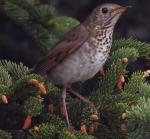
|
Bicknell's Thrush
|
Overview
Bicknell's Thrush: Small thrush, olive-brown upperparts, buff breast with brown spots, white or buff belly. Eye has faint gray ring. Upper mandible black with pale base, lower mandible yellow with black tip. Tail, rump have rust-brown wash. Swift, direct flight with jerky wing strokes. |
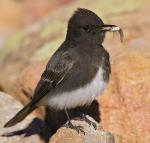
|
Black Phoebe
|
Overview
Black Phoebe: Medium flycatcher, mostly black body and white belly. Outer tail feathers and undertail coverts are white. Bill, legs, feet are black. Feeds primarily on insects, sometimes small fish. Weak fluttering bouyant flight with shallow wing beats. Sallies from perch to catch insects in air. |
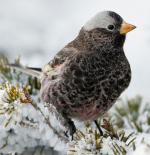
|
Black Rosy-Finch
|
Overview
Black Rosy-Finch: Medium finch with black-brown breast and back, and gray headband. Belly, rump, and wing patches are pink mixed with brown. Forages on ground and in shrubs, grasses and snowfields. Eats seeds and insects. Swift bounding flight, alternates rapid wing beats with wings pulled to sides. |

|
Black-and-white Warbler
|
Overview
Black-and-white Warbler: Small, black-and-white striped warbler with a white median head stripe bordered by black. Black bill, legs and feet. It forages unlike any other warbler by moving up and down the trunks of trees and crawling under and over branches in a style similar to that of a nuthatch. |
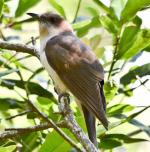
|
Black-billed Cuckoo
|
Overview
Black-billed Cuckoo: Medium cuckoo with brown upperparts, white underparts. Eye-ring is red and decurved bill is black. Tail is long with faint white, dark-eyed spots underneath. Feeds primarily on caterpillars, also eats insects, small fish, mollusks and fruits. Makes low flights of short duration. |
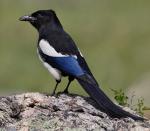
|
Black-billed Magpie
|
Overview
Black-billed Magpie: Large, noisy jay, mostly black, with very long tail and dark, stout bill. Wings and tail are iridescent blue and green-black. White belly and sides. Eats insects, larvae, carrion. Direct flight on shallow, steady wing beats. Often glides between perches or from perch to ground. |
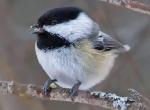
|
Black-capped Chickadee
|
Overview
Black-capped Chickadee: Medium-sized, stocky chickadee with pale gray upperparts and breast and pale olive-brown underparts. The black cap and bib and white cheeks are conspicuous. Black bill is short and thin. Wings are dark with broad white edges on feathers. State bird of Maine and Massachusetts. |
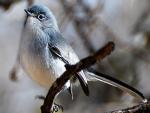
|
Black-capped Gnatcatcher
|
Overview
Black-capped Gnatcatcher: Very small. Black cap, blue-gray upperparts, black tail, gray white underparts. Long slender black beak. The outer tail feathers mostly white gives underside of tail a white appearance when tail closed. Weak fluttering direct flight with shallow wing beats. |

|
Black-capped Vireo
|
Overview
Black-capped Vireo: Small vireo, olive-green upperparts, black hood, white spectacles interrupted with black above the eye, white underparts with olive-yellow flanks. Wings are dark with two pale bars. Iris is red-brown to red. It has been listed as an endangered species since 1987. |
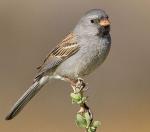
|
Black-chinned Sparrow
|
Overview
Black-chinned Sparrow: Medium sparrow, plain, dark gray with brown-streaked back, pale gray belly, black chin and pale eyestripe. Bill is pink. The legs and feet are yellow-gray. Forages in brush and on ground. Short flights on rapidly beating wings alternating with periods of wings pulled to sides. |
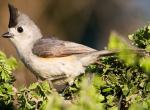
|
Black-crested Titmouse
|
Overview
Black-crested Titmouse: Large titmouse with gray upperparts, pale gray underparts, and rust-brown flanks. The head has black cap and crest, pale gray face, and pale eye-ring. Wings and tail are gray. Gray legs and feet. Was once considered a subspecies of the Tufted Titmouse. AKA Mexican Titmouse. |
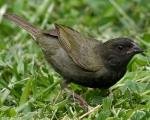
|
Black-faced Grassquit
|
Overview
Black-faced Grassquit: Small sparrow, very dark olive-gray with black head and breast. Black bill, legs and feet. Very common in the West Indies. Feeds mainly on seeds, especially of grasses and weeds. The flight is weak, bouncy and fluttering. Alternates rapid wing beats with pulling wings to body. |
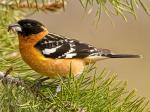
|
Black-headed Grosbeak
|
Overview
Black-headed Grosbeak: Large, stocky finch, black-streaked, orange-brown back, black head, wings, tail. Breast is orange-brown and belly is yellow. Wings have conspicuous white patches. Black legs, feet. Forages on ground and in trees and bushes. Eats insects, caterpillars, seeds, fruits and berries. |
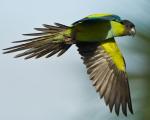
|
Black-hooded Parakeet
|
Overview
Black-hooded Parakeet: Medium parakeet, green overall, black head, chin, yellow eye-ring. Blue wash on throat and breast, deep blue outer webs on flight feathers and tips of tail feathers. Flight, tail feathers are gray underneath. Cheeks and underwing linings are pale yellow-green. Rump is yellow. |

|
Black-tailed Gnatcatcher
|
Overview
Black-tailed Gnatcatcher: Medium gnatcatcher with black cap, blue-gray upperparts, black tail, and pale gray underparts. The bill is short and black. Black tail is edged with white; underside of tail appears mostly black with large white spots near tip when closed. Black legs and feet. |
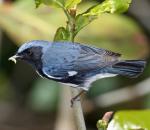
|
Black-throated Blue Warbler
|
Overview
Black-throated Blue Warbler: Small warbler that is the most strikingly sexually dimorphic of all wood warblers. Male has dark blue upperparts, black throat and mask. White underparts with black sides and white wing patch at base of primaries. Bill, legs and feet are black. The female is olive-brown. |
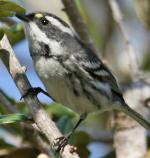
|
Black-throated Gray Warbler
|
Overview
Black-throated Gray Warbler: Small warbler, black-marked, slate-gray upperparts, black streaks on flanks, white underparts. Head has black hood and throat, sharply contrasting white eyebrow and cheek stripe, and yellow spot in front of eye. Wings are dark with two white bars. Black bill, legs, feet. |
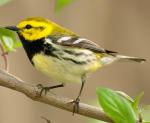
|
Black-throated Green Warbler
|
Overview
Black-throated Green Warbler: Medium-sized warbler with olive-green upperparts, black-streaked flanks, and white underparts. Face is yellow with black eyestripe and bill. Crown is olive green. Throat and upper breast are black. Wings are dark with two white bars. Tail is dark. Black legs and feet. |
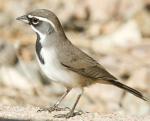
|
Black-throated Sparrow
|
Overview
Black-throated Sparrow: Medium sparrow, gray-brown upperparts, white underparts, black bib. Head has dark gray cap and sharply contrasting white eyebrow and cheek stripe. Bill is black. Long, round-tipped tail is edged with white. Legs and feet are gray. Forages on the ground and in low vegetation. |
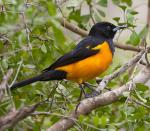
|
Black-vented Oriole
|
Overview
Black-vented Oriole: Large oriole with black hood, upper back, wings, and tail, including vent. Underparts and lower back are bright yellow-orange. Black bill is long and slender. Legs and feet are gray. Forages in trees and bushes. Feeds on insects, berries and fruit. Strong, swift, direct flight. |
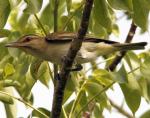
|
Black-whiskered Vireo
|
Overview
Black-whiskered Vireo: Large vireo with olive-green upperparts and olive-buff washed white underparts. The head has gray crown, dark whiskers (moustache stripe) along sides of throat, white eyebrow with black border, and red-brown eyes. The bill is black, straight, and slightly hooked. |
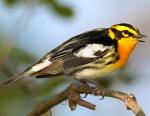
|
Blackburnian Warbler
|
Overview
Blackburnian Warbler: Medium warbler, yellow-orange head, black cap and cheek patch, and orange throat. Upperparts are black with white stripes and underparts are white with black- streaked flanks. Wings have prominent white patches. The tail is black with white on outer tail feathers. |
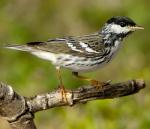
|
Blackpoll Warbler
|
Overview
Blackpoll Warbler: Medium-sized warbler with black-streaked, gray upperparts, white underparts, and black-streaked white sides. Head has black cap and prominent white cheek patch. Bill is black. Wings are dark with two white bars. Pink legs and feet. Swift, direct flight with rapidly beating wings. |
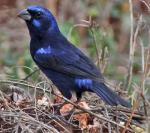
|
Blue Bunting
|
Overview
Blue Bunting: Small, stocky brightly colored bunting. The male (shown in background) is deep blue overall with black face and upper breast and a stout, black bill. The female (shown in foreground) is uniformly brown with a gray bill. Forages on ground, in thickets and in brushy understory for seeds, insects and larvae. Short flight; alternates rapid wing beats with wings pulled briefly to sides. |
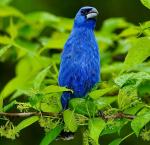
|
Blue Grosbeak
|
Overview
Blue Grosbeak: Large finch, bright purple-blue body, black face, and two wide, brown wingbars. Dark wings, tail. Hops on ground to forage. Gleans from bushes, weeds and trees. Feeds on insects, snails, grains, seeds and fruits. Swift flight, alternates rapid wing beats with wings pulled to sides. |
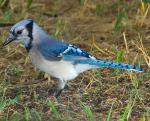
|
Blue Jay
|
Overview
Blue Jay: Medium, noisy jay with bright blue upperparts, pale gray underparts, distinct head crest, and neck surrounded with a curious black necklace. Black-barred wings and tail have prominent white patches. Direct flight with steady and bouyant wing beats. Glides between perches or to the ground. |
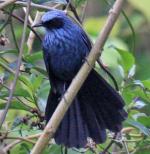
|
Blue Mockingbird
|
Overview
Blue Mockingbird: This large thrush is slate blue with pale blue streaks on the crown and a black mask and red eye. Native of Mexico and casual in winter in southeast Arizona and accidental in New Mexico, California, and Texas. A very secretive bird, skulks in dense underbrush while searching for insects and fallen fruit. |
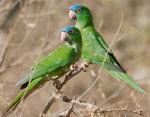
|
Blue-crowned Parakeet
|
Overview
Blue-crowned Parakeet: Medium-sized green parakeet with a blue head and red-orange highlights in long tail. White, feathless eye ring. The bill is bicolored with upper mandible pinkish and lower mandible is black (subspecies in northeastern Brazil has an all-pink bill). The legs and feet are pink. |
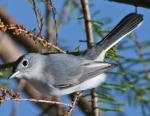
|
Blue-gray Gnatcatcher
|
Overview
Blue-gray Gnatcatcher: Small, flycatcher-like perching bird, blue-gray upperparts, white underparts, prominent white eye-ring. Wings are dark. Black tail is long and white-edged. Forages in thickets, trees and shrubs for insects, their eggs and larvae. Weak fluttering flight on shallow wing beats. |
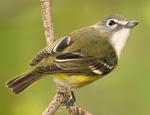
|
Blue-headed Vireo
|
|
Overview
Blue-headed Vireo: Medium-sized vireo with olive-green upperparts, white underparts, and yellow flanks. Head has blue-gray hood, white spectacles, and white throat. The wings are dark with two white or pale yellow bars. Weak, fluttering flight with rapid wing beats. May hover briefly. |
|
|